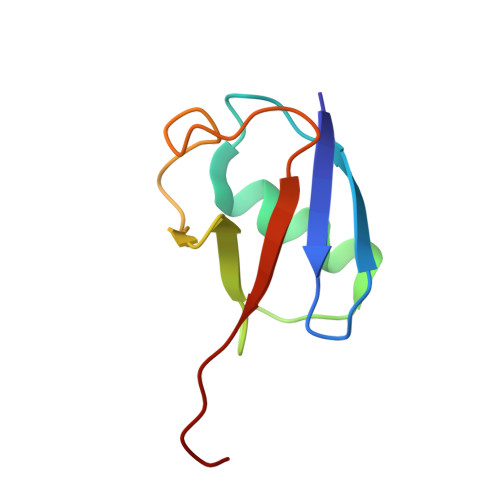Paramagnetic relaxation enhancement-assisted structural characterization of a partially disordered conformation of ubiquitin.
Wakamoto, T., Ikeya, T., Kitazawa, S., Baxter, N.J., Williamson, M.P., Kitahara, R.(2019) Protein Sci 28: 1993-2003
- PubMed: 31587403
- DOI: https://doi.org/10.1002/pro.3734
- Primary Citation of Related Structures:
6K4I - PubMed Abstract:
Nuclear magnetic resonance (NMR) is a powerful tool to study three-dimensional structures as well as protein conformational fluctuations in solution, but it is compromised by increases in peak widths and missing signals. We previously reported that ubiquitin has two folded conformations, N 1 and N 2 and plus another folded conformation, I, in which some amide group signals of residues 33-41 almost disappeared above 3 kbar at pH 4.5 and 273 K. Thus, well-converged structural models could not be obtained for this region owing to the absence of distance restraints. Here, we reexamine the problem using the ubiquitin Q41N variant as a model for this locally disordered conformation, I. We demonstrate that the variant shows pressure-induced loss of backbone amide group signals at residues 28, 33, 36, and 39-41 like the wild-type, with a similar but smaller effect on CαH and CβH signals. In order to characterize this I structure, we measured paramagnetic relaxation enhancement (PRE) under high pressure to obtain distance restraints, and calculated the structure assisted by Bayesian inference. We conclude that the more disordered I conformation observed at pH 4.0, 278 K, and 2.5 kbar largely retained the N 2 conformation, although the amide groups at residues 33-41 have more heterogeneous conformations and more contact with water, which differ from the N 1 and N 2 states. The PRE-assisted strategy has the potential to improve structural characterization of proteins that lack NMR signals, especially for relatively more open and hydrated protein conformations.
- Graduate School of Life Sciences, Ritsumeikan University, Kusatsu, Shiga, Japan.
Organizational Affiliation:
















